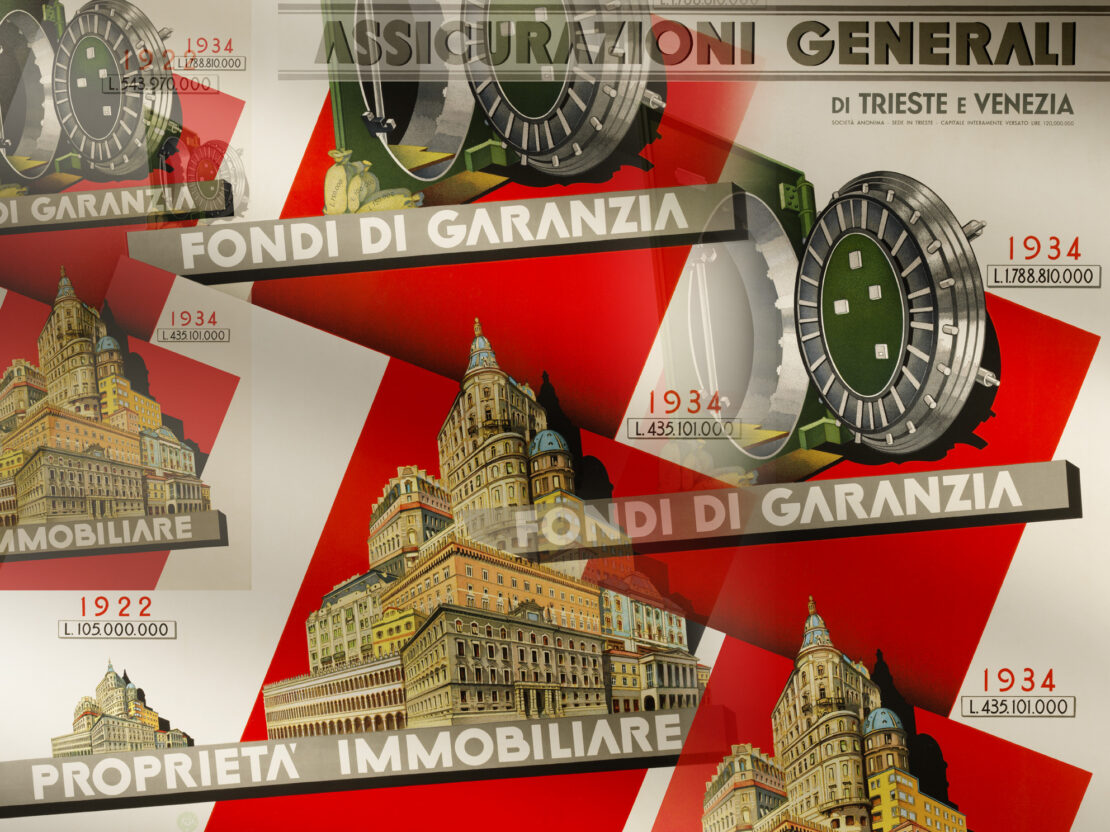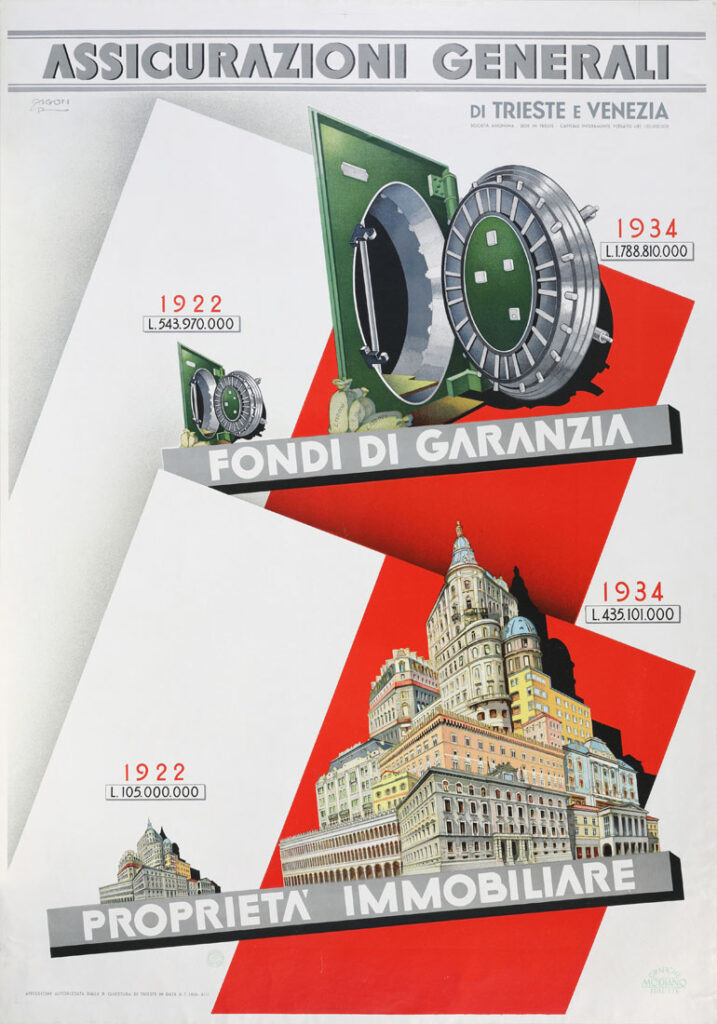The Generali Group Real Estate Heritage — in Photos
22 November 2024
Photographs: a fascinating archival source, perhaps the most suggestive of all, with implications that extend beyond the purely iconographic and into the emotional. They convey visual and perceptive stimuli that restore a lively impartiality to the world “as it was”, often offering a helpfully stark juxtaposition with the world “as it is”. For this reason, photography is of great reciprocal value with other important fields such as architecture, both for what it tells us as well as for the reality it builds and conveys.
The artistic photography of Massimo Gardone offers an alternative vision of the “City of Generali” created by Trieste-born poster designer Pollione Sigon for the Company’s 1935 advertising poster. It offers a prompt for reflection on how Generali utilised the photography of spaces, architecture and landscapes over the years, frequently employing prominent local and Venetian photography studios (Wernigg, Franceschinis, Pozzar, Giacomelli, Ferruzzi among others) and demonstrates the variety of photographs preserved for their various purposes: editorial, advertising, documentary and as gifts.
The Generali Archive contains a fascinating collection of historical photographs. One well-documented category — in terms of preservation as well as publication — is that of Generali’s real estate assets.
The urban offices and agricultural estates owned by the Company, in Italy and abroad, combined to form guarantee funds. These are among the most important lines on the budget, and by dint of being a distinct branch of the business, not to mention the necessary financial commitments, they required increasingly detailed descriptions, including visual evidence, such as the annual budget supplements (1935-1943) and the records of the real estate and agricultural properties that accompanied the budgets (1949-1970).
These publications drive the preservation of proper albums that offer visual evidence of the development of construction projects, especially those owned by the Company, and the modus operandi of the time within the construction sector: construction techniques, and loose materials intended for trade publications.
Il Centenario delle Assicurazioni Generali, published by the Company in 1931, has a whole chapter dedicated to urban and agricultural property, offering the first overview (and the core of the photography collection) of the Company’s most iconic historic buildings. These demonstrate Generali’s ongoing commitment to real estate investment over the years, not only as places of work and hosting but also for residential purposes.
It coincided with the publication of an album, or rather a collection of photographs, most likely intended as a gift (on the cover is embossed the slogan for the Company’s centenary celebrations: Novo incepto saeculo) that perfectly encapsulates the Company’s most significant real estate investments, and more importantly, the vision of the director (and later president) of Generali, Marco Besso. In the 1880s, he launched the Company’s real estate policy, later writing in his Autobiografia “… it was my wish, I said, that Assicurazioni Generali choose the most prominent locations in our biggest cities for our head offices, all decorated with our beloved Lion.”
Staying with the field of publishing, of particular importance are the two editions of La proprietà immobiliare urbana e agricola [“Urban and Agricultural Real Estate Property”], published by the Company in 1951 and 1963. These were updated versions of previous editions, that went into greater detail in terms of new acquisitions as well as in its iconographic notes regarding the relevant positives preserved in the Archive.
Additional photographic material preserved from campaigns commissioned for editorial purposes regards the monographs dedicated to the historical headquarters of Generali in Italy. These include Palazzo Carciotti and Palazzo Stratti in Trieste, Palazzo Cordusio in Milan, Palazzo Venezia in Rome and the Procuratie Vecchie in Venice, or the Ca’ Corniani agricultural estate in Caorle (Venice).
In recent years, the latter two of these sites have been at the heart of important reclamation and renovation projects. Two new publications dedicated to these projects have been published, filled with photos that highlight the works carried out. These can be found in the Archive’s digital library.
There is great value in the photos of interiors taken on institutional milestones such as career anniversaries or important moments in the history of the Company: as well as putting faces to familiar names, they also provide evidence of furnishings, decor or spaces that were later replaced and modernised.
Individual photos or collections offer proof of the use — or occasionally reuse — of photography for different purposes, but always serving to rebuild a picture of the “City of Generali” over time. This city, imagined as a whole yet real in its unicity, is of single buildings drawn and then placed one alongside the other in Arrigo Russi’s work from the early 1930s. It relies contemporaneously on the photographs taken for the volume marking the Company’s centenary and on the collection Novo incepto saeculo.
A “metropolitan” city that embraces the totality of Generali’s work around the world, yet is firmly grounded in Trieste, the city where Generali was founded in 1831, with the backdrop of Piazza dell’Unità d’Italia and the San Giusto Hill. A city that found a perfect encapsulation in the poster by Pollione Sigon and a new artistic aesthetic in Massimo Gardone’s photograph.
![Arrigo Russi, The city of Generali [early 1930s] ph. Massimo Gardone (2021)](https://heritage.generali.com/wp-content/uploads/2022/10/Citta-Generali-1024x768.jpg)


![Palazzo Piacentini, Trieste — Via Tor Bandena, [1937] / ph. Foto C. Wernigg](https://heritage.generali.com/wp-content/uploads/2024/10/9-1024x765.jpg)
![Palazzo delle Assicurazioni Generali, Rome — Piazza Venezia 11, in album Novo incepto saeculo, [1931]](https://heritage.generali.com/wp-content/uploads/2019/02/3-palazzo-piazza-Venezia-Roma-1024x841.jpg)
![Ca’ Corniani, Caorle, main courtyard — agency — mill / ph. Ferruzzi, Venice [1st half of 20th century]](https://heritage.generali.com/wp-content/uploads/2024/10/3-1024x808.jpg)
![Palazzo Geiringer, Trieste — Piazza Duca degli Abruzzi 2, executive room / ph. G. Franceschinis [1920]](https://heritage.generali.com/wp-content/uploads/2024/10/Generali_Group_Gallery_GNR4203_pr-1.jpg)